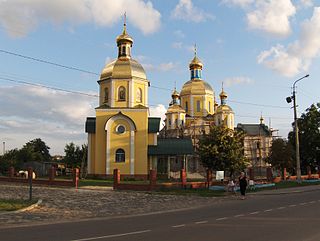Related Research Articles

Pomerania is a historical region on the southern shore of the Baltic Sea in Central Europe, split between Poland and Germany. The central and eastern part belongs to the West Pomeranian, Pomeranian and Kuyavian-Pomeranian voivodeships of Poland, while the western part belongs to the German states of Mecklenburg-Western Pomerania and Brandenburg.
A county is a geographic region of a country used for administrative or other purposes in some nations. The term is derived from the Old French comté denoting a jurisdiction under the sovereignty of a count (earl) or, in his stead, a viscount (vicomte). Literal equivalents in other languages, derived from the equivalent of "count", are now seldom used officially, including comté, contea, contado, comtat, condado, Grafschaft, graafschap, and zhupa in Slavic languages; terms equivalent to 'commune' or 'community' are now often instead used.
A unitary authority is a local authority responsible for all local government functions within its area or performing additional functions that elsewhere are usually performed by a higher level of sub-national government or the national government.

A powiat is the second-level unit of local government and administration in Poland, equivalent to a county, district or prefecture in other countries. The term "powiat" is most often translated into English as "county" or "district". In historical contexts, this may be confusing because the Polish term hrabstwo (an administrative unit administered/owned by a hrabia is also literally translated as "county".

Karkonosze County is a unit of territorial administration and local government (powiat) in Lower Silesian Voivodeship, south-western Poland. It came into being on January 1, 1999, as a result of the Polish local government reforms passed in 1998.

The gmina is the basic unit of the administrative division of Poland, similar to a municipality. As of 1 January 2019, there were 2,477 gminy throughout the country, encompassing over 43,000 villages. Nine hundred and forty gminy include cities and towns, with 322 among them constituting an independent urban gmina consisting solely of a standalone town or one of the 107 cities, the latter governed by a city mayor.

Dzierzgoń is a town in the Pomeranian Voivodeship in northern Poland. It is located in Sztum County east of Malbork and south of Elbląg on the river Dzierzgoń. Dzierzgoń has a population of 5,242, while the town and its environs have a combined population of about 10,000.

Starostwo is an administrative unit established from the 14th century in the Polish Crown and later in the Polish–Lithuanian Commonwealth until the partition of Poland in 1795. Starostwos were established in the crown lands (królewszczyzna). The term continues to be used in modern Poland.

The administrative division of Poland since 1999 has been based on three levels of subdivision. The territory of Poland is divided into voivodeships (provinces); these are further divided into powiats, and these in turn are divided into gminas. Major cities normally have the status of both gmina and powiat. Poland currently has 16 voivodeships, 380 powiats, and 2,478 gminas.

Berezne is a city in Rivne Oblast, Ukraine. It is located on the Sluch River north of Rivne. It was the administrative center of Berezne Raion until it was merged with Rivne Raion in 2020. Population: 13,126.

Bydgoszcz County is a unit of territorial administration and local government (powiat) in Kuyavian-Pomeranian Voivodeship, north-central Poland. It was created on 1 January 1999 as a result of the Polish local government reforms passed in 1998. Its administrative seat is the city of Bydgoszcz, although the city is not part of the county. The only towns in Bydgoszcz County are Solec Kujawski, which lies 17 km (11 mi) east of Bydgoszcz, and Koronowo, 23 km (14 mi) north of Bydgoszcz.

Polesie Voivodeship was an administrative unit of interwar Poland (1918–1939), named after the historical region of Polesia. It was created by the Council of Ministers of the Second Polish Republic on February 19, 1921, as a result of peace agreement signed with the Russian and Ukrainian SSRs in Riga. Polesie Voivodeship was the largest province of interwar Poland. It ceased to function in September 1939, following the Nazi-German and Soviet invasion of Poland in accordance with a secret protocol of the Nazi–Soviet Pact of non-aggression.
Białystok, like other major cities in Poland, is a City with powiat rights. The Legislative power in the city is vested in the unicameral parliament, the Białystok City Council, which has 28 members. Council members are elected directly every four years, one of whom is the mayor, or President of Białystok. Like most legislative bodies, the Białystok City Council divides itself into committees which have the oversight of various functions of the city government. Bills passed by a simple majority are sent to the mayor, who may sign them into law. If the mayor vetoes a bill, the council has 30 days to override the veto by a two-thirds majority vote. The current President of Białystok, elected for his first term in 2006, is Tadeusz Truskolaski.

The National Electoral Commission is the only permanent election commission in Poland. The second permanent electoral organs are komisarze wyborczy, which number is 51.

LGBT-free zones were municipalities and regions of Poland that have declared themselves unwelcoming of LGBTQ rights, in order to ban equality marches and other LGBTQ events. By June 2020, some 100 municipalities (map) and five voivodeships, encompassing a third of the country, had adopted resolutions which have been characterised as "LGBTQ-free zones". On 6 February 2024, Warsaw Voivodship Administrative Court repealed the last "LGBTQ-free zone" in Poland.
References
- ↑ "Dz.U. z 1998 r. nr 91, poz. 578 (Sjem of the RP)" (in Polish). Retrieved 2011-04-16.
- ↑ Central Statistical Office (2 January 2018). "Baza TERYT: Wyszukiwanie" [TERYT Database: Search] (in Polish). Select "miasta na prawach powiatu" from "kategoria/rodzaj" and press "Wyszukaj". Retrieved 1 September 2018.